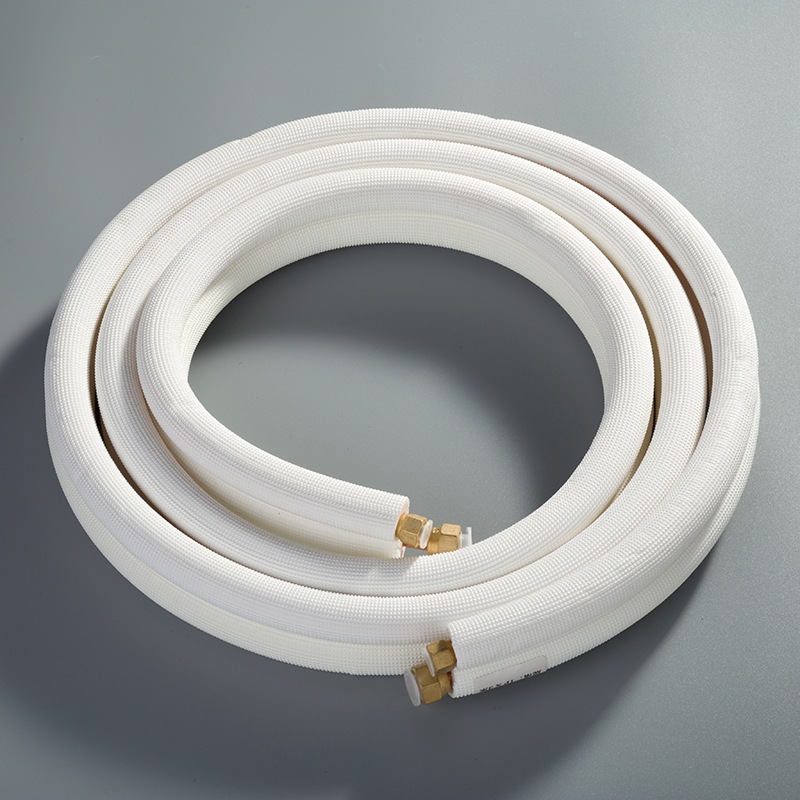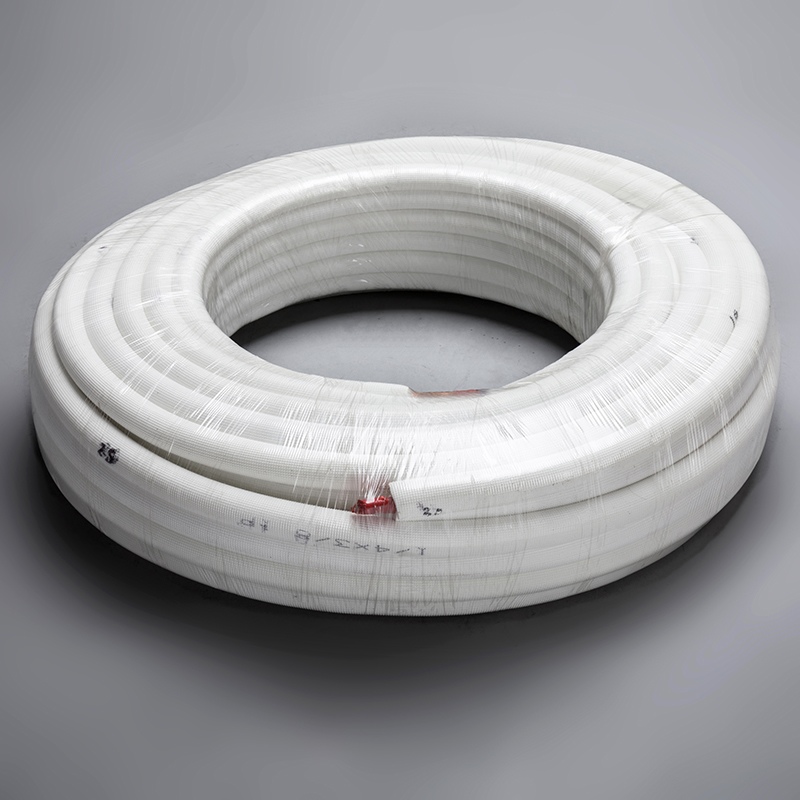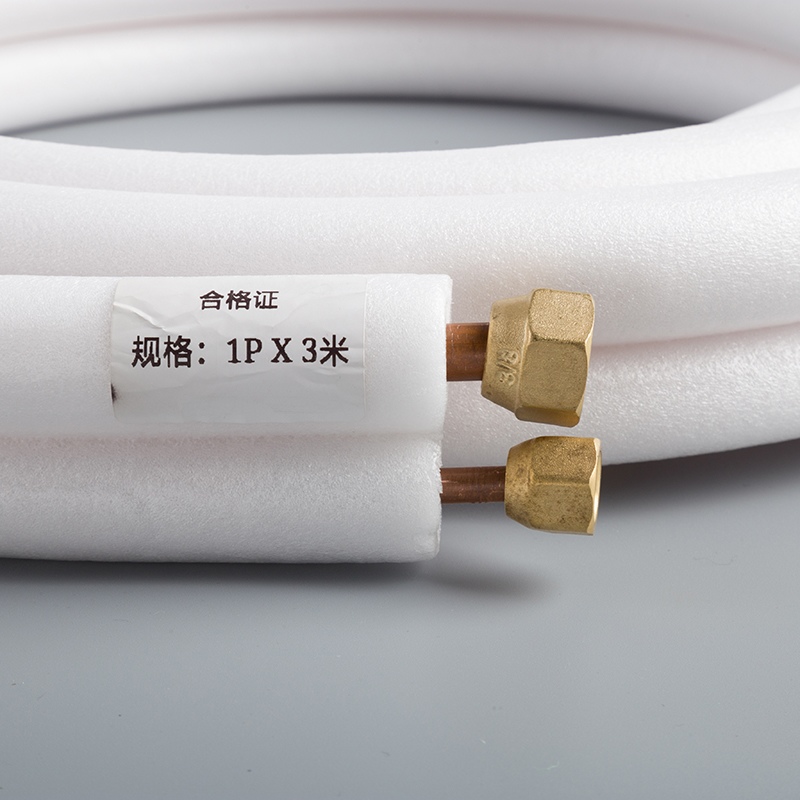How Copper Pipe Insulation Enhances Air Conditioner Efficiency

Properly addressing an air conditioner copper pipe leak and ensuring effective air conditioner copper pipe insulation are essential for maintaining the efficiency of your cooling system. Without adequate insulation, several problems can arise:
Condensation may develop, leading to water damage and potential mold growth.
Energy loss can occur, driving up your energy bills by as much as 20%.
Noise transmission becomes more apparent, disrupting your comfort at home.
In colder climates, uninsulated pipes are at risk of freezing and bursting, resulting in expensive repairs.
By focusing on air conditioner copper pipe insulation, you can prevent these issues while also tackling concerns like an air conditioner copper pipe leak. Proper insulation reduces energy consumption, prevents condensation, and extends the lifespan of your system. This straightforward measure ensures consistent cooling performance and helps you save money over time.
Key Takeaways
Wrapping copper pipes can cut energy bills by 30%. It stops heat loss and makes the system work better.
Good insulation stops water drops, keeping pipes safe from damage and mold.
Picking the right material, like foam, rubber, or fiberglass, is key for better performance and lasting use.
Check your insulation often for damage to keep your air conditioner working well and lasting longer.
Covering copper pipes not only makes your home comfy but also saves money on repairs and energy over time.
The Role of Copper Pipes in Air Conditioning Systems
Why Copper is Ideal for Air Conditioning Systems
Copper plays a vital role in air conditioning systems due to its unique properties. Its high durability ensures that it withstands extreme temperatures without losing structural integrity. Unlike other metals, copper resists corrosion, erosion, and rust, making it a long-lasting choice for HVAC systems. This durability reduces the need for frequent repairs, saving you time and money.
Another reason copper is ideal is its excellent heat conductivity. It transfers heat quickly, which enhances the efficiency of your air conditioning system. This means your system consumes less energy to cool your home, lowering your energy bills. Additionally, copper's antimicrobial properties improve indoor air quality. It prevents the growth of bacteria, mold, and mildew on HVAC surfaces, which can otherwise cause unpleasant odors and reduce system efficiency. These benefits make copper a superior material compared to alternatives like aluminum.
How Copper Pipes Facilitate Cooling Efficiency
Copper pipes are essential for the heat exchange process in air conditioning systems. Their ability to conduct heat efficiently ensures that both the evaporator and condenser coils perform optimally. This quick heat transfer directly impacts the system's cooling performance, helping maintain a comfortable indoor temperature.
The smooth inner surface of copper pipes minimizes friction, allowing refrigerant to flow effortlessly. This reduces energy loss and enhances the overall energy efficiency of your system. Insulating copper pipes further boosts their performance by reducing heat transfer and maintaining cooler water temperatures. Proper insulation also minimizes heat loss, ensuring that your air conditioning system operates at peak efficiency. These features not only improve cooling performance but also lower operational costs, making copper pipes a cost-effective and environmentally friendly choice.
Benefits of Air Conditioner Copper Pipe Insulation

Improved Energy Efficiency
Insulating copper pipes significantly enhances energy efficiency in your air conditioning systems. By minimizing heat transfer, insulation helps maintain consistent indoor temperatures. This reduces the workload on your HVAC system, allowing it to operate more efficiently. As a result, you can experience energy savings of up to 30% on utility bills.
In homes and businesses, proper insulation can reduce energy consumption by as much as 20%. For commercial buildings and industrial plants, the savings are even more substantial over time. Insulation also stabilizes temperatures in chilled water systems and reduces heat loss in hot water systems. This eliminates the need for frequent reheating, further lowering energy usage.
Context | Energy Savings Percentage |
|---|---|
Commercial buildings | 10-20% |
Industrial plants | Significant over time |
Homes and businesses | Up to 20% |
Prevention of Condensation
Preventing condensation is another critical benefit of copper pipe insulation. Without insulation, moisture can accumulate on the surface of cold pipes when exposed to warm, humid air. This often leads to water damage, mold growth, and dripping onto floors in humid areas.
Insulation acts as a thermal barrier, keeping the pipe’s surface temperature above the dew point. This prevents condensation from forming. Materials like foam sleeves, rubber wraps, and fiberglass insulation are commonly used for this purpose. By insulating copper pipes, you not only keep the pipes dry but also protect the surrounding areas from potential damage. This simple step ensures a safer and more efficient cooling system.
Enhanced System Longevity
Insulating copper pipes protects them from environmental damage, extending the lifespan of your air conditioning systems. Insulation minimizes temperature fluctuations, which reduces thermal expansion and contraction. This helps prevent stress on pipe joints and fittings, preserving the system's integrity.
Additionally, insulation prevents moisture buildup, reducing the risk of corrosion over time. By maintaining stable temperatures, it also minimizes wear and tear on your HVAC system. Insulated pipes are less likely to deteriorate from thermal stress, even in extreme weather conditions. This leads to fewer repairs and replacements, saving you money on maintenance costs.
By insulating copper pipes, you ensure long-term durability and reliability for your cooling system. This investment not only enhances performance but also reduces the likelihood of costly breakdowns.
Consistent Cooling Performance
Insulating copper pipes plays a crucial role in ensuring consistent cooling performance in your air conditioning system. Without insulation, temperature fluctuations can disrupt the system's efficiency and lead to uneven cooling. By insulating the pipes, you stabilize the internal temperatures, which helps maintain a steady and reliable cooling output.
One of the key benefits of copper lines insulation is its ability to reduce heat transfer. This makes it easier for your HVAC system to maintain the desired indoor temperature. Insulation eliminates extreme temperature swings, ensuring that your home stays comfortable even during peak summer months.
Tip: Consistent cooling performance not only improves comfort but also reduces energy consumption, saving you money on utility bills.
Here are some ways insulation contributes to consistent cooling:
It stabilizes temperatures within the pipes, preventing condensation and corrosion.
It maintains consistent internal temperatures in both hot and cold water systems, promoting energy efficiency.
It reduces operational strain on the HVAC system, lowering the risk of component failure.
By insulating copper pipes, you also enhance the overall reliability of your air conditioning system. Stable temperatures reduce the workload on critical components like water heaters and chillers, extending their lifespan. This means fewer repairs and replacements, which translates to long-term savings.
In addition, air conditioner copper pipe insulation ensures that your system operates at peak efficiency. By reducing heat transfer, it minimizes energy loss and keeps your cooling system running smoothly. This simple yet effective measure guarantees consistent indoor conditions and enhances your overall comfort.
Types of Insulation Materials for Copper Pipes

Foam Insulation
Foam insulation is a popular choice for copper pipes in air conditioning systems due to its affordability and ease of installation. This material, often made from polyethylene foam, provides excellent thermal resistance, helping maintain water temperature and reducing energy loss. Its moisture-resistant properties prevent condensation, protecting pipes from corrosion and surrounding areas from water damage. Additionally, foam insulation absorbs vibrations, reducing noise from water flow and pipe movement.
Property | Description |
|---|---|
Thermal Insulation | Polyethylene foam provides effective thermal resistance, maintaining water temperature in pipes. |
Moisture Resistance | High resistance to moisture prevents condensation on cold pipes, protecting against corrosion. |
Vibration and Noise Reduction | Absorbs vibrations, reducing noise from water flow and pipe movement, enhancing comfort. |
However, foam insulation has some drawbacks. It is less durable than other materials and may require frequent replacement, especially in high-temperature applications. Despite these limitations, its low cost and ease of use make it a great option for residential projects.
Advantages | Disadvantages |
|---|---|
Easy to install, especially for DIY enthusiasts. | Less durable than other insulation materials. |
Affordable, making it a good option for residential projects on a budget. | May need to be replaced more frequently. |
Provides both thermal insulation and moisture protection. | Limited temperature resistance, with performance deteriorating in extremely high-temperature applications. |
Rubber Insulation
Rubber insulation stands out for its durability and efficiency. It resists environmental factors like UV radiation, ozone, and moisture, ensuring long-lasting performance. This material minimizes heat transfer, conserving energy and reducing operational costs. Its closed-cell structure enhances thermal efficiency, making it ideal for maintaining consistent temperatures in copper pipes.
High thermal efficiency minimizes heat transfer.
Closed-cell structure reduces thermal conductivity.
Helps in conserving energy and cutting operational costs.
Rubber insulation also offers specific benefits for air conditioning systems. It prevents condensation, protecting pipes from corrosion and mold growth. Additionally, it absorbs vibrations and sound, creating a quieter indoor environment. Its durability ensures reliable performance under various conditions, making it a preferred choice for both residential and commercial applications.
Thermal Insulation: Effectively resists heat transfer, reducing energy loss and lowering energy bills.
Condensation Prevention: Creates a barrier that prevents condensation on pipes and surfaces.
Noise and Vibration Dampening: Absorbs vibrations and sound, contributing to a quieter indoor environment.
Durability: Withstands temperature changes, moisture, and UV rays, maintaining its insulating properties over time.
Fiberglass Insulation
Fiberglass insulation is another excellent option for copper pipes. It prevents heat transfer, reducing energy usage and improving system performance. This material maintains refrigerant temperature effectively, ensuring faster cooling and consistent operation. By dampening vibrations, fiberglass insulation also contributes to quieter air conditioning systems.
Enhanced Energy Efficiency: Prevents heat transfer, reducing energy usage.
Improved System Performance: Maintains refrigerant temperature effectively for faster cooling.
Noise Reduction: Dampens vibrations, leading to quieter operation.
Fiberglass insulation offers long-term benefits for copper pipes. It protects them from UV rays, physical impacts, and weather erosion, enhancing the resilience of air conditioning systems. However, it may become brittle in extreme cold, increasing the risk of cracking and moisture absorption. Despite this, its ability to withstand low temperatures makes it a reliable choice for many applications.
Tip: Insulating copper pipes with fiberglass can lead to annual energy savings of 10-15%, offering a solid return on investment.
Choosing the Right Insulation Material
Selecting the right insulation material for copper pipes in air conditioning systems is crucial for maximizing efficiency and ensuring long-term performance. Each material offers unique properties, so understanding your specific needs will help you make the best choice.
Here are some key factors to consider when choosing insulation materials:
Material Types: Polyethylene foam, rubber, and fiberglass each have distinct characteristics. Foam is lightweight and easy to install, rubber excels in durability, and fiberglass offers excellent thermal resistance.
Environmental Conditions: The local climate plays a significant role. For example, humid areas may require moisture-resistant materials, while extreme temperatures demand insulation with high thermal stability.
Installation Techniques: Proper installation ensures the insulation performs effectively. Materials like foam sleeves are easier for DIY projects, while fiberglass may require professional handling.
The right insulation material directly impacts the efficiency of your air conditioning system. Proper insulation reduces heat flow, making it easier for the system to maintain comfortable indoor temperatures. This not only lowers energy consumption but also reduces strain on the HVAC unit, enhancing its performance and lifespan. A well-insulated home minimizes heat transfer, which prevents your system from overworking and keeps energy costs in check.
Different materials, such as fiberglass, foam, and rubber, influence efficiency in unique ways. Fiberglass excels in maintaining refrigerant temperatures, foam minimizes condensation, and rubber provides durability against environmental factors. By choosing the right material, you can enjoy the benefits of copper lines insulation, including consistent cooling, energy savings, and extended system longevity.
Tip: Always match the insulation material to your specific needs and environmental conditions. This ensures optimal performance and long-term savings.
How to Insulate Copper Pipes Effectively
Tools and Materials Needed
To insulate copper pipes effectively, you need the right tools and materials. These ensure a smooth installation process and optimal results. Here’s a list of essentials:
Tape Measure: Accurately measure the length of insulation required.
Duct Tape: Secure insulation and cover seams to prevent gaps.
Adhesive (Armaflex 520): Provides a strong bond and resists moisture.
Narrow Pieces of Wood: Support pipes to avoid compressing the insulation.
Insulation Materials: Options include foam sleeves, rubber wraps, and fiberglass.
Safety Gear: Protect yourself with safety glasses, dust masks, and sturdy boots.
Having these items ready ensures you can complete the job efficiently while maintaining safety.
Step-by-Step Guide to Insulating Copper Pipes
Follow these steps to insulate copper pipes and achieve improved cooling efficiency:
Measure the length of the pipes using a tape measure.
Clean the pipe surfaces thoroughly to remove dirt and grease.
Choose the appropriate insulation material based on your needs.
Cut the insulation to match the pipe measurements.
Wrap the insulation snugly around each pipe section.
Secure the insulation with adhesive or duct tape to prevent gaps.
Inspect the insulation regularly and replace any damaged sections.
Tip: For bends in the pipes, cut the insulation at an angle to ensure a tight fit. This prevents air leaks and ensures reduced energy loss.
Common Mistakes to Avoid
Avoid these common mistakes to ensure your insulation performs effectively:
Using the Wrong Material: Inappropriate materials may lack the thermal resistance needed for maintaining efficiency.
Leaving Gaps or Compressing Insulation: Gaps allow air to enter, reducing effectiveness, while compression diminishes thermal resistance.
Skipping UV Protection: Outdoor pipes exposed to sunlight need UV-resistant materials to prevent degradation.
Improper insulation can lead to significant air loss, forcing your HVAC system to work harder. This increases energy bills and causes unnecessary wear and tear. By avoiding these mistakes, you can ensure your system operates efficiently and lasts longer.
Insulating copper pipes in your air conditioning system is a straightforward way to boost efficiency and save money. Proper insulation reduces heat flow, making it easier for your system to maintain comfortable indoor temperatures. This leads to lower energy bills and less strain on the equipment. Over time, you can recoup the initial cost of insulation through annual energy savings of 10-15%.
By preventing condensation, insulation protects your pipes and surrounding areas from damage. It also extends the lifespan of your system by reducing wear and tear. With reliable air conditioner copper pipe insulation, you ensure consistent cooling performance and long-term cost savings. This simple upgrade enhances comfort and keeps your HVAC system running efficiently for years to come.
FAQ
What is the purpose of insulating copper pipes in air conditioning systems?
Insulating copper pipes helps maintain consistent temperatures, reduces energy consumption, and prevents condensation. This simple step improves cooling efficiency, extends the system's lifespan, and protects against potential damage caused by moisture or temperature fluctuations.
How does insulation contribute to preventing energy loss?
Insulation minimizes heat transfer between the pipes and the surrounding air. This helps your air conditioning system maintain the desired temperature more efficiently, reducing energy waste and lowering utility bills.
Which insulation material is best for copper pipes?
The best material depends on your needs. Foam is affordable and easy to install, rubber offers durability and moisture resistance, and fiberglass provides excellent thermal insulation. Consider environmental conditions and system requirements when choosing.
Can I install copper pipe insulation myself?
Yes, you can install it yourself with basic tools like a tape measure, duct tape, and insulation material. Follow a step-by-step guide to ensure proper installation. For complex systems, professional assistance may be better.
How often should I replace copper pipe insulation?
Inspect insulation regularly for wear or damage. Replace it if you notice cracks, gaps, or moisture buildup. High-quality materials like rubber or fiberglass may last longer, reducing the need for frequent replacements.
See Also
Enhance Air Conditioning Performance Using Copper Pipe Insulation
The Importance of Pure Copper Pipes for Air Conditioning
Reasons to Opt for Copper Pipes in Air Conditioning
Key Benefits of Copper Pipes in Air Conditioning Systems
Transforming Air Conditioning Efficiency with Pure Copper Pipes


